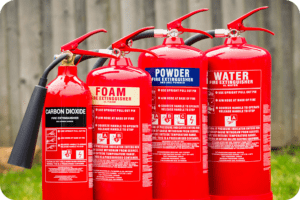
In a densely populated and fast-paced city like Hong Kong, fire safety is not just a precaution—it’s a necessity. Whether you’re managing a commercial building, an office, a warehouse, or a restaurant, portable fire extinguishers play a critical role in first-line defense. These compact yet powerful tools are designed to suppress small fires before they escalate into devastating emergencies.
But owning a fire extinguisher isn’t enough—it must be the right type, placed in the right location, and kept in proper working condition. This guide will walk you through essential knowledge about fire extinguisher types, when and how to use them, and how to stay compliant with local safety regulations.
Where Should Fire Extinguishers Be Placed?
Under the Hong Kong Fire Services Department(HKFSD) regulations, fire extinguishers must be:
Ensuring proper placement isn’t just about legal compliance—it’s about maximizing speed and effectiveness in a real emergency.
Understanding Fire Classes & Extinguisher Types
Different fires require different extinguishing agents. Here’s a quick reference to match the right tool to the right type of fire:
How Do Different Fire Extinguishers Work?
Dry Powder Extinguishers
Best for: Class A, B, and C fires. Dry powder extinguishers release a fine chemical powder that interrupts the fire’s chemical reaction and separates the fuel from oxygen.
Picture an underground car park, a small engine fire caused by a fuel leak is quickly suppressed with a nearby dry powder unit—preventing a wider disaster.
Water Extinguishers
Best for: Class A fires. These extinguishers cool burning materials to remove the heat element of the fire triangle.
Imagine a smouldering cigarette ignites a bin of paper waste in an office. A staff member extinguishes the flames swiftly using a water extinguisher—avoiding damage to the entire floor.
Foam Extinguishers
Best for: Class A and B fires. Foam extinguishers form a blanket over flammable liquids, cutting off oxygen and cooling the surface.
Consider during routine work in a paint warehouse, a small spill catches fire. A foam extinguisher prevents it from spreading across the facility.
CO₂ (Carbon Dioxide) Extinguishers
Best for: Class E (electrical) fires. These leave no residue and won’t damage sensitive equipment. CO₂ displaces oxygen and cools the fire zone.
An electrical panel sparks inside a shopping mall. A trained employee uses a CO₂ extinguisher to put out the fire quickly—without harming the electronics.
Wet Chemical Extinguishers
Best for: Class F fires (cooking oils and fats). Specialized agents cool the oil and form a soapy layer to prevent re-ignition.
In a busy restaurant, an overheated deep fryer bursts into flames. The chef uses a wet chemical extinguisher to safely suppress the fire before it spreads to the ventilation system.
The Importance of Regular Fire Extinguisher Inspection
Having the right extinguisher is only half the battle—it must also be properly maintained to ensure functionality during an emergency.
ACSL’s Complete Fire Extinguisher Services Include:
Fire extinguishers are small tools with enormous responsibility. The right fire extinguisher, used correctly, can save lives and prevent large-scale damage. Whether you manage a commercial building, shopping mall, restaurant, or office, keeping your extinguishers in top condition is both a legal requirement and a moral responsibility. Trust ACSL for expert desgn, installation, and maintenance of fire safety solutions across Hong Kong.